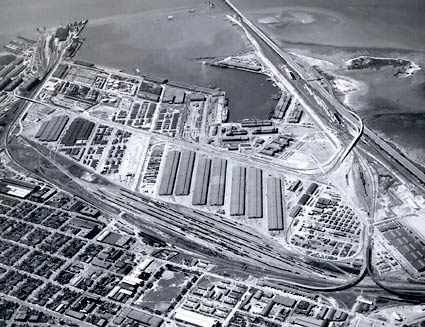
1950 aerial view of the Oakland Army Base, situated just south of the San Francisco Bay Bridge. (Port of Oakland Archives-Pacific Gateway Collection)
The base was commissioned on the day after the Japanese military attack on Pearl Harbor, as the Oakland Sub-Port of the San Francisco Port of Embarkation. In conversation with ROHO interviewers, 48 individuals weave its story: servicemen and women who passed through the base en route to WWII battlefields and wars in Korea, Vietnam, and the Persian Gulf; longshoremen who loaded and unloaded military vessels; civilian employees; and politicians and local citizens involved in the base’s closure in 1999 and the ongoing effort to find new uses for its 425 acres of prime waterfront.
Themes explored
The ROHO team set out to explore three themes in particular, notes U.S. history specialist Martin Meeker, who conducted some of the interviews and edited the new companion book, The Oakland Army Base: An Oral History, which provides highlights from ROHO’s 200-plus hours of OAB interviews. For starters the researchers sought to document the base’s core functions, which ran the gamut from moving troops and weapons to serving, until 1985, as the major West Coast mortuary for returning U.S. war dead.

Book featuring highlights of 200-plus hours of interviews.
“I ended up doing government travel requests … for the deceased bodies and their escorts that came back from Vietnam, …” recalls Janice McDonald, a long-time civilian Department of Defense employee. “Every time I saw an escort — there were about 50 of them at the counter, … an escort for each body — it was like ‘oh my God.'”
Interviewees also describe the base as a community unto itself — complete with stores, eateries, housing, social facilities, a church, charity projects, and holiday traditions — and recall its relationship with the world beyond its gates, particularly its West Oakland neighbors.
After a stint in the Air Force, Grant Davis worked at OAB as a civilian employee, in transportation management, for more than three decades. He offers a nuanced account of the “big split” he felt when — as a patriotic-minded African American vet just back from Vietnam — he encountered both housing discrimination and Black Panther critiques of the military-industrial complex.
The informants themselves, as well as the professionals posing the questions, shape the oral history. A number of long-term OAB civilian employees talk about being hired initially as a GS1 or 2 and moving steadily up the civil-service job ladder to GS 12, 13, or 14. The military made that possible by offering a high-school education, through an arrangement with Oakland Technical High School, not only to military personnel but civilian employees, and then opportunities to earn an MBA or additional professional training.
‘A chapter that now is over‘
The “big story” that emerges from the interviews, says Meeker, is how the army base helped people from hard circumstances pursue the American Dream. In this way, OAB and other military installations had a profound social impact on the Bay Area, which was home to more than a dozen bases, among them Moffett Field, Alameda Naval Air Station, Oakland Army Hospital, Fort Mason, the San Francisco Presidio, Treasure Island Naval Base, and Mare Island Naval Shipyard.

Military personnel working on college degrees while stationed at Oakland Army Base, 1980. (Courtesy of Jim Johnson)
“Undoubtedly billions of dollars were pumped into the Bay Area economy to help mostly disadvantaged people get training, get educated, move into the middle class,” Meeker says. “For me the most interesting and compelling story to come out of this is the unintended consequences of the military leaving the Bay Area.”
In the wake of a series of base closures stretching from 1988 to 2005, Coast Guard Island and a small portion of the former Concord Naval Weapons Station are the only remaining military complexes between Fairfield and Monterey, he notes. “The military in the Bay Area was extraordinarily prominent from the Gold Rush to the beginning of this century. That’s a chapter that now is over.”
Informants offer wide-ranging speculation as to why the Bay Area was so hard hit by the Base Realignment and Closure Commission, as it was known — theories ranging from the area’s liberal, anti-military bent to the acquiescence of individual politicians. Whatever the reasons, the fact that stateside military bases are now concentrated in “red” states “contributes to the political Balkanization of the U.S.,” Meeker believes.
The oral history was commissioned by the Port of Oakland and the City of Oakland partly on the strength of ROHO’s contributions to Rosie the Riveter National Historic Park, in Richmond, Calif. Now, as the book puts it, a fertile and extensive new archive, available online to all, “awaits its scholars to study and write the complete history of the OAB — and of the urban military base in the West.”
Related links:
• ROHO’s Oakland Army Base oral history
website
•
Transcripts
of Oakland Army Base oral-history interviews
•
Interview video
on the Oakland Army Base and the American Dream (YouTube)
• ROHO’s Rosie the Riveter oral history
website

